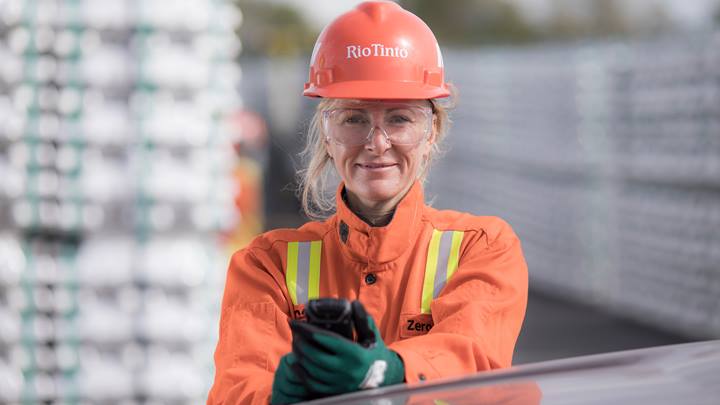PVTIME – Rio Tinto is outlining the actions being taken to strengthen the business and improve performance. It is also unveiling a longer-term strategy to ensure it thrives in a decarbonising world and continues to deliver attractive shareholder returns, in line with its policy.

The deployment of the Rio Tinto Safe Production System is underway to ensure the Group regains its position as Best Operator. The Group is combining systematic long-term programmes with rapid improvement activities targeted at bottlenecks in order to reduce operational variability and increase resilience.
Governments are setting more ambitious targets and accelerating actions on climate change. Society at large is also demanding companies take more action to decarbonise. To meet the challenge, stay relevant and capture the opportunity Rio Tinto is raising its ambition and taking actions.
The Group is unveiling a new target to reduce its Scope 1 & 2 carbon emissions by 50 per cent by 2030, more than tripling its previous target. A 15 per cent reduction in emissions is now targeted for 2025, five years earlier than previously. These targets are supported by around $7.5 billion of direct investments to lower emissions between 2022 and 2030.
In recognition of the broader carbon footprint of the commodities it produces, Rio Tinto will accelerate its investment in R&D and development of technologies that enable its customers to decarbonise. Working in partnership with governments, suppliers, customers, academia and others Rio Tinto will continue to develop technologies like ELYSISTM for carbon-free aluminium and multiple pathways to produce green steel.
To meet additional demand created by the global drive to net zero emissions, Rio Tinto will prioritise growth capital in commodities vital for this transition with an ambition to double growth capex to about $3 billion a year from 2023.
Rio Tinto can decarbonise, pursue growth and continue to deliver attractive returns to shareholders due to its strong balance sheet, world-class assets and focus on capital discipline.
Rio Tinto Chief Executive Jakob Stausholm said “Rio Tinto is taking action to strengthen our business and improve our performance by unleashing the full potential of our people and assets, working in partnership with a broad range of stakeholders.
“All our commodities are vital for the energy transition and continue to benefit from ongoing urbanisation. We have a clear pathway to decarbonise our business and are actively developing technologies that will enable our customers and our customers’ customers to decarbonise.
“We are able to do this, while continuing to provide attractive returns to our shareholders in line with our policy, because we have a strong balance sheet and world-class assets that deliver strong free cash flows through the cycle.”
Key points from the presentation include:
- Rio Tinto is targeting a 50% reduction in scope 1&2 emissions by 2030 and a 15% reduction by 2025 from a 2018 baseline of 32.6Mt (CO2 equivalent – equity basis).
- ~$7.5 billion in direct capital expenditure decarbonising Rio Tinto’s assets from 2022 to 2030, with a focus on renewable power for iron ore in the Pilbara and for the Australian aluminium smelters, including $0.5 billion per year from 2022 to 2024.
- ~$200 million of incremental operating expenditure on building new capabilities, energy efficiency initiatives and R&D.
- Overall capital guidance of ~$7.5 billion in 2021 (unchanged), ~$8 billion in 2022 (previously ~$7.5 billion) and an ambition to spend between $9 billion and $10 billion per year in 2023 and 2024. This includes sustaining capital of ~$3.5 billion a year (previously $3.0-3.5 billion), of which $1.5 billion a year relates to Pilbara Iron Ore.
Iron ore
- Medium-term Pilbara iron ore system capacity of between 345 million and 360 million tonnes per year (on a 100% basis)1.
- Decarbonisation of the Pilbara will be accelerated by targeting the rapid deployment of 1GW of wind and solar power. This would abate around 1 million tonnes of CO2, replace natural gas power for plant and infrastructure and support early electrification of mining equipment.
- Full electrification of our Pilbara system, including all trucks, mobile equipment and rail operations, will require further gigawatt-scale renewable deployment and advances in fleet technologies.
- Options to provide a greener steelmaking pathway for Pilbara iron ore are being investigated, including with biomass and hydrogen.
Aluminium
- Rio Tinto Aluminium is the most profitable integrated aluminium business with an advantaged position in renewable energy.
- Options are progressing to switch the Boyne Island and Tomago smelters in Australia to renewable energy, which will require an estimated ~5GW (equity basis) of solar and wind power, along with a robust firming solution.
- A potential attractive structural change in the aluminium market driven by continued demand growth and supply-side constraints including ongoing pressures on fossil-fuel sourced energy.
- Development of ELYSISTM to eliminate carbon emissions from the smelting process is progressing, with commercial scale technology on track for 2024.
1 Mid-term defined as upon completion of the next tranche of new and replacement mines including Western Range, Bedded Hill Top and Hope Downs 2 and Brockman Syncline to reach and sustain capacity. These mines are expected to start commissioning from 2025. To reach and sustain the upper end of the range requires the next tranche of replacement mines due between 2025 and 2027.










